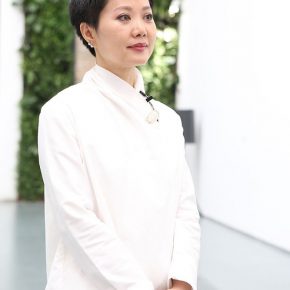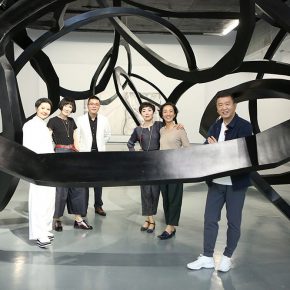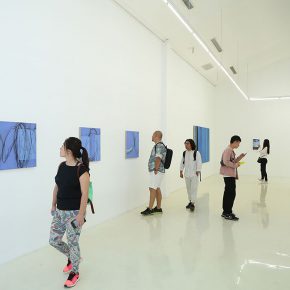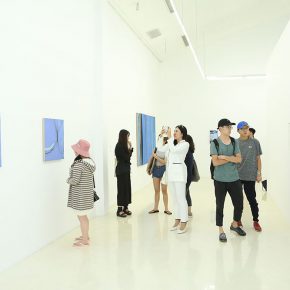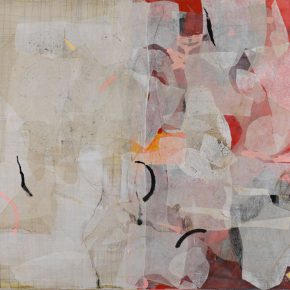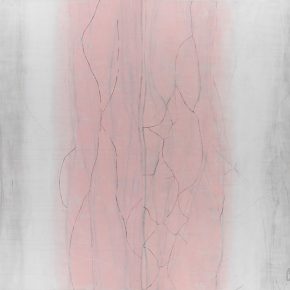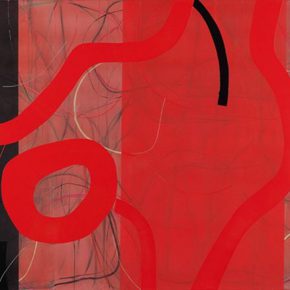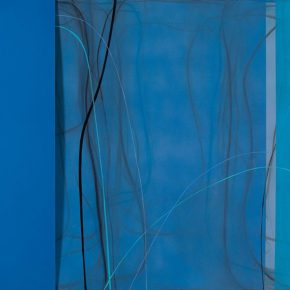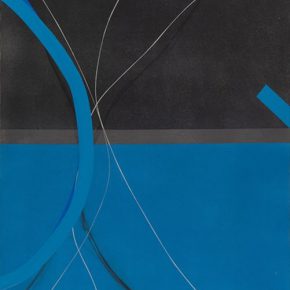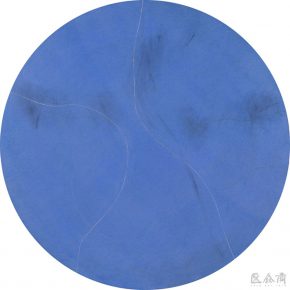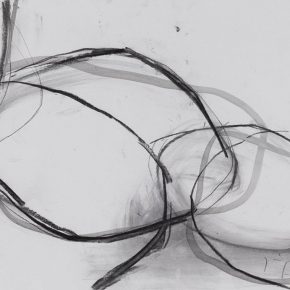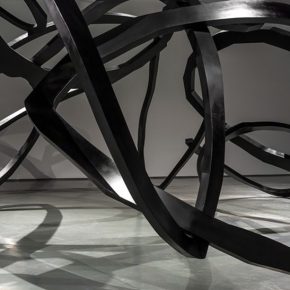
On September 10, 2017, “The Ring of Life: Zhou Li Solo Exhibition” opened at the Hive Center for Contemporary Art (Beijing), The Ring of Life is, after White Shadow (Yuz Museum, Shanghai, 2017), another exhibition on a grand scale, curated by the scholar and curator Chia Chi Jason Wang, the exhibition showcases Zhou’s paintings over recent years and her latest installation entitled “The Ring of Life”. Before the opening of the exhibition, the artist Zhou Li participated in an exclusive interview with the CAFA ART INFO, with a detailed interpretation of the style and path of her artistic creation.
Date: September 7, 2017
Venue: Hive Center for Contemporary Art (Beijing)
Interviewer: Wei Xiankun (hereinafter referred to CAFA ART INFO)
Interviewee: Zhou Li (hereinafter referred to as Zhou)
Translated by Chen Peihua and edited by Sue/CAFA ART INFO
CAFA ART INFO: Why do you hold a solo exhibition in Beijing so soon after the solo show was held in Yuz Museum, Shanghai in the first half of this year? Compared with the last show, what is the difference with this exhibition?Zhou: Hive Center for Contemporary Art invited me to hold a solo exhibition three years ago, but it did not become a reality for many reasons, and I found the time was ripe this year, so I decided to finish it. I would like to choose the works depending on the theme and direction of the exhibition. The last exhibition in Shanghai was in favor of “memories”, and this exhibition returns to my usual thinking and creative context, more emphasis on continuity, it presents my previous exploration direction in the language of art works.
CAFA ART INFO: This exhibition is entitled “The Ring of Life”, and you once said that “ring” symbolized a complete connection that failed to have a beginning or an end. This feature is combined with the character of “life”. Do you want to convey a state of life? How do you understand the development and natural emotion of this state of life?Zhou: Yes, it is. In my opinion, it is naturally formed. Literally, I am more interested in the “ring”, and I have always thought that life is in a state of spiraling, and this concept is related to the reincarnation and circulation emphasized in oriental Buddhism. I think it has this awareness in the traditional Chinese culture and painting, for example, I like Huang Binhong, and all things are constantly changing and inter-promoting each other, so that, it gives viewers a feeling that the space is constantly flowing. The “qi” is a very unique concept in the traditional Chinese culture, and when this idea is expounded to abstract painting, it also makes the abstract painting of China emphasis the things that are different from the ones stressed by Western abstract painting.
CAFA ART INFO: The critic Huang Zhuan once reviewed that your works contain a “possibility of infinitely viewing”, as a viewer, I feel “infinity” seems to be multifaceted, involved in both the infinity of the life status that you have just talked about, and the movement that is constantly changing in your works. Then, how do you understand “infinity”?
Zhou: In my opinion, this infinity is fundamentally the problem of “qi”. For example, my sculpture exhibited in this exhibition, I made a model in paper earlier and there were many complex lines in the beginning, which looked like a cloud of breath. I hoped both the painting and sculpture had a sense of movement, and it also stressed the traditional Chinese art, for example, the blank areas in ink painting, which is used to create “stomas” of the screen of the painting. Sculpture can also be “flowing”. As the largest sculpture located in the exhibition hall is a public sculpture that will be placed in the outdoor space, it is more powerful. It is determined by the relationship between the work and the space. In addition, I also show a small sculpture made of paper in the exhibition hall, which looks very light, so that one can feel the contrast between the light and weight in the exhibition.
CAFA ART INFO: I found a variety of edges and corners which are not seen in the painting or in your sculptures, does it mean that different viewing relationships affect the shaping of the lines of your creation?Zhou: It must be influential. Those edges and corners of sculptures were debugged inch by inch, so that the viewer can see a different linear shaping from each perspective, and the overall feeling is different. In addition, I prefer to call my sculpture an “installation”, with a broader meaning of the word, representing a more open way of viewing.
CAFA ART INFO: Perhaps because the sculpture or installation is the entity located in the real space, it is necessary for its lines to have a beginning and an end, but in the viewer’s vision, the lines are the entity which extend to the screens of paintings in the exhibition hall, and the relationship between lines of sculpture and painting and also change along with the viewer that shifts their gaze. The meaning of “ring” presents a new visual possibility. Is your creative context full of relationships between sculpture and painting constantly and mutually effected?Zhou: You’re right. At the beginning, I was engaged in the creation of painting, and then I finished a sculpture of woven lines made of titanium alloy, which was also big, and it had a particularly interesting change when the sculpture was hung in the air. I returned to the reflection of the screen from that work.
CAFA ART INFO: Is your current creation unfolded around the mutual relationship between sculpture and painting?Zhou: It does it in a current stage. I am also interested in image, but I have not yet begun to create. In fact, Shanghai’ solo exhibition was arranged through an image, to place works that are like “light boxes” in a dark environment. If I create a work of an image in the future, I will still use abstract as my creative language, and I hope that the work makes people feel peaceful.
CAFA ART INFO: In your paintings, there are many lines in fluorescent white, so that lines also have a light sensation, what is the purpose of your creative approach?Zhou: I hope that the lines in the painting give people a sense of floating in space, and when one sees the work in a dark environment, the lines are indeed “three-dimensional”, and perhaps I will use other ways to make lines really “floating” in the future.
CAFA ART INFO: Seeing your work in the exhibition hall, the audience is often able to feel a sense of immersion, which is ultimately the mental aura transmitted by you. How do you maintain the “qi” in your daily life?Zhou: I have this sense of immersion when I create, and it is the reason why I insist on the creation, it makes me feel like it is a pleasure and detached. This immersion might not be quiet, and it is linked to my emotions. Usually I like to write calligraphy, listen to music, and everything in life is related to the “maintaining” of “qi”.
CAFA ART INFO: In traditional Chinese calligraphy and painting, the issue of “lines inter-promoting lines” is often talked about, and the title of the exhibition “The Ring of Life” is also of a similar meaning, it seems that it is related to the training of Chinese calligraphy and your understanding of calligraphy.Zhou: I think the “traditional” nourishment is very important, in addition to calligraphy, which is one of the representatives. Chinese calligraphy is very moving, especially in the era of communication with letters. It is like meeting a person and learning his character when his letters were seen. However, viewing calligraphy is not a process of reading, but a process of appreciation. If people can escape from the framework of “recognizing a letter by figure”, they can appreciate abstract art.
CAFA ART INFO: Do you have any thought or plan for your following creation?Zhou: I can’t predict what I will or what I can do in the future, but I will try my best to make my artistic life longer, wider, maintaining scalability, realizing “the ring of life”.


